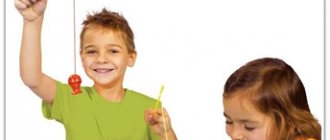Tic-Tac-Toe Championship
Previously, every second schoolchild knew this game, but for some reason today’s students increasingly prefer computer strategy games or shooting games. Therefore, it will be useful to stretch your mind with an interesting and entertaining game of tic-tac-toe. Everything is very simple: 2 opponents, a board and chalk, a simple grid is drawn, if desired, 2 by 2, 3 by 3, and so on. The task of each participant is to place his cross or zero on one line faster than his opponent and cross it out. The winner receives a prize. At the end, you can have a battle of the strongest and find out which of the guys is the coolest in this matter.
Birthday contests for children 14 years old at home
“Guess the person by description”
The game is suitable for a group of friends who know each other well. The names of all participants in the game are written on separate pieces of paper, and then the pieces of paper are shuffled and distributed in random order.
Each of the guys in turn must describe the person whose name is written on the piece of paper that fell to him, and the rest try to guess who they are talking about. It is advisable not to touch upon items of clothing and accessories in the description, based on the personal qualities and characters of the participants in the game.
"Bottle"
During the game you will not need to give kisses to the participants. First, prepare an empty plastic bottle.
All players sit in a circle on the floor. There is one participant in the center of the circle with a bottle in his hand. The participants in the game call each other's names, and the player with the bottle must hit the person named on the head with the bottle (lightly, of course). Each time the next name is called by the one whose name was just spoken. And, most importantly, you need to say your friend’s name as quickly as possible so that the driver doesn’t have time to hit you with a bottle. Anyone who didn’t have time and was still hit with a bottle becomes the driver.
"Pantomime"
Pre-prepared cards with one word written on them are randomly distributed to private traders. The player will have to depict the object denoting this word as something else. This must be done without words, using facial expressions and pantomimes. If no one guessed what the player was trying to portray within 2-3 minutes (by agreement), he is considered a loser and performs some kind of penalty task (for example, crowing).
Words that can be written on cards:
- TV,
- fork,
- shaving foam,
- cat,
- cucumber,
- tractor,
- barrel.
It is not easy to depict the desired object or phenomenon. Participants guess, and the “actor” can nod his head if they are close to the solution. Usually the game causes a lot of emotions and laughter.
"Mummy"
Two or three couples are selected from the company, preferably three boys and three girls. They are divided into pairs, and each pair is given a roll of white toilet paper. The task of each of the girls is to make a “mummy” out of their partner by wrapping him in paper from head to toe. The competition has 2 minutes, so participants will have to hurry. After time has passed, the “jury” (guys who did not take part in the competition) evaluates whose “mummy” is more plausible. The winners receive a small prize.
"Hot potato"
A well-known game that has become traditional at weddings and other holidays. Participants sit at a table and pass each other an object (for example, a ball, an orange, a glass of drink, etc.) to the music. When the music stops, the participant who has the “potato” in his hands must stand up and congratulate the birthday person by making a toast.
"Broken phone"
The participants of the game are seated in a circle. The beginner comes up with any word or phrase (for example, “happy birthday”) and quietly speaks this phrase into the ear of his neighbor once. A neighbor passes on what he hears to his neighbor, and so on. The task of each player is to prevent other participants from hearing what he said, otherwise he is eliminated from the game. The game is funny because at the other end of the line, namely at the end of the chain, the phrase takes on a completely different meaning or is completely different from what was originally stated.
Competition "Who is faster?"
There can be several tasks, each time a new pair or three players can compete.
Examples of tasks:
- who can eat half a lemon faster?
- who can drink a glass of juice faster?
- who can peel the potatoes faster?
- Who can cut an apple into 10 pieces faster?
- who can make the name of the birthday boy out of grapes faster?
- Who can build a tower out of 20 plastic cups the fastest (there should be 5 cups at its base).
The winners are awarded.
"Blowing the Clock"
Two young men are selected from the company and invited to compete with each other in blowing... yes, a clock! And they will need to do this with their eyes closed. A wristwatch is placed in the middle of the table. Participants sit opposite each other. The rules of the game are announced to them: whoever moves the clock gets it.
The players are blindfolded and carefully replace the clock lying in front of them with a plate of flour, which they, of course, have no idea about.
"Search for Flowers"
In one of the rooms, some time before the game, paper flowers are hidden (in the closet, under the table, under the trunk, behind the chest of drawers, on the chandelier, etc.). The participants of the game enter the room at the same time and begin to look for flowers. Whoever finds the most flowers wins. Similar birthday contests are suitable for girls 14 years old at home.
"Burst the Balloons"
Each participant in the game is given three inflated balloons. Everyone’s task is to burst them as quickly as possible without touching them with their hands and teeth. The rest of the guys are fans.
"Water Carriers"
Three brave and dexterous ones are selected from the company. They need to carry a glass of water on their head across the room without dropping it or spilling water. Whoever completes the task first wins. It is better to use plastic glasses.
"Take off your hat"
The participants of the game enter the designated circle. Each player's left arm is tied to the body. Everyone has a hat on their head. The task is this: take off the hats of your rivals, but at the same time do not allow anyone to rip the hat off your head. This is not an easy task for a one-armed player. Anyone who loses a hat is out of the game. The last player remaining in the hat wins.
"Guess the identity"
To play you need a screen. It can serve as a blanket. A girl is hiding behind a screen. The host asks the company questions about the details of her clothing, makeup and appearance. For example, “What color are her eyes?”, “Which hand is the girl’s watch on?”, “What metal are her earrings made of?” For each correct answer, participants are given 1 point. At the end of the game, the points are tallied and the winner is declared.
Games with teenagers
Yes Yes! Big children also love to play, although it is difficult for them to admit it. "What? Play? We’re not in kindergarten!” these serious people say, but once you start, there’s no limit to your delight.
They run around and frolic with complete dedication, absolutely sincerely rejoicing. The main thing in this matter (as in many others) is the support of adults. That's why these are games with teenagers, not for teenagers!
What games can there be?
- Warm-up games. As a rule, these are outdoor games where it is important to run and move. Their task corresponds to the name - to warm up in order to start playing more complex games (team games, communication games), or, on the contrary, you can use them to finish a “serious” game. They can also be used on their own as a way to relieve stress, laugh, and have fun.
- Team. They help the group unite, feel like a single team, be closer to each other (and how important this is for counselors!), and develop personal relationships.
- Thanks to communication games, it will be possible to get to know each other better, expand the boundaries of ordinary “everyday” communication, and make it deeper and more interesting.
This division is quite arbitrary. All of the listed groups of games can be entertaining in nature, or they can also be serious and make you think about something.
Why play games?
As a rule, the purpose of games is to relieve tension, warm up, and laugh. Games help us be closer to each other. They also have a developmental value: they train memory, attention, imagination, as well as the ability to control oneself, relate one’s interests to the interests of others, be in the center of attention and lead in a group. Thanks to some of them, children learn to talk about serious life problems. Moreover, and importantly, they provide a fun time. And by playing together with the counselors, teenagers will see that the counselors are not so boring after all... And, perhaps, the game will be a bridge to trust between you.
A few simple recommendations
- As you already understand, counselors participate in the game along with teenagers. Your sincere desire to have fun together will help you start the game, while instructions like “now I will tell you how you will play” discourage any desire to do this.
- It's worth starting with warm-up games with simple, easy-to-remember rules.
- In games where a leader is needed, the choice should be entrusted to the guys.
- It is important to stop in time. It's good to have 2-3 games - usually after the 3rd game the energy level drops, the children get tired and get bored. Therefore, pay attention to the level of activity, and at the first signs of fatigue, gently stop playing.
- You can get pleasure not only from the game, but also from discussing it.
Warm-ups
Winks
This game requires an odd number of participants (from 11 to 25 people). The group is divided into 2 parts. The chairs are placed in a circle. One half of the group sits on chairs facing in a circle, the other half of the group stands behind the chairs. Thus, it turns out that everyone sitting on a chair has his own pair behind his back, a participant who guards him. One chair remains free and the task of the one standing behind it is to lure anyone sitting to his chair without his “guard” noticing. The task of the “security guard” is not to let in (catch) “his” sitting person. In order for a person to be “caught”, it is enough to simply put your hands on his shoulders (it is not allowed to grab his hair or clothes).
Methods of luring can be different: winks (hence the name of the game), gestures, nods of the head, simply addressing the person - anything! The game should take place at a fairly fast pace; it is important for those sitting not to miss the signal and to “escape” from their pair in time to an empty chair. The effects are relaxation, unity, and the manifestation of personal relationships (especially between boys and girls!). The game is fun in groups of different sexes.
Hugging tulle
A very fun workout! From 6 to 30 people can participate. The game is played in the same way as regular tag, with a small but pleasant addition: the driver cannot tag the one who has a pair! (you need to hold on to the couple tightly, or better yet, hug). If a three is formed, anyone can be salted. And if a couple stands hugging for more than 3 seconds, you can also salivate (this is important for the dynamic play of the game). The game helps to relax, run, laugh, and gain the experience of mutual assistance and “saving physical contact.”
Fruit basket
Good workout. The number of participants is from 6 to 15. Participants sit in a circle, the leader is in the center. Everyone comes up with a name for the fruit. The presenter says which fruits he bought at the market, and they must change places. Several fruits can be named at once. The presenter's task is to have time to take a seat. The one who is left without a place becomes the leader.
Terribly beautiful drawing
Static game. Participants are given a sheet of paper and one felt-tip pen. Everyone sits in a circle. It is suggested to draw a “beautiful picture.” After this, the drawing is simultaneously transferred to the neighbor on the right, and he makes a “terrible drawing” from the received drawing within 30 seconds, and everyone simultaneously passes on their “terrible” drawings to the next one. The next participant makes a “wonderful drawing” from a “terrible” one, also in 30 seconds. This goes around the whole circle. The drawing is returned to the owner and the result is discussed. As a result of the game, the group process is stimulated, discharged, and aggression is expressed. Number of participants 7-12 people.
Chair on the right
Any number of participants. The chairs are placed in a circle, everyone is sitting on chairs, one chair is empty, the driver is in the center. The driver's task is to take a chair. The player for whom the empty chair is under his right hand must “protect” the chair and prevent the leader from sitting on it. To do this, he must perform 2 actions: slap it with his right hand and call the name of any of the participants in the game before the driver sits on it. If you don’t have time, you become the driver yourself. If he succeeds, the named player sits on this chair, and the task of the new player, from whom the newly vacated chair is on the right, is, in turn, to have time to “protect” his chair from the driver. You need to act and think very quickly, otherwise the game will be boring. A very fun, noisy warm-up, and also a great way to get to know each other - while you defend your “chair on the right”, you will learn all the names!
Birds, fleas, spiders
Number of participants: from 10 people. A spacious room is required. The group is divided into two teams. Each team, secretly from the other, decides who they will be - “birds”, “spiders” or “fleas”. Teams stand in 2 lines in the center of the hall facing each other (“wall to wall”). At the command of the leader, they simultaneously show each other a gesture indicating the selected animal. Gestures need to be agreed upon in advance. Spiders run away from birds, fleas run away from spiders, birds run away from fleas (sounds like “rock, paper, scissors”). Anyone who does not have time to reach the opposite wall is caught by the opposing team, and the participant joins their team. And everything is repeated again, usually it is interesting to carry out no more than 6-7 runs.
House mice
Participants unite in threes - two take each other by both hands, depicting a “house”, and the third - a mouse - is in the ring of their hands. At the command of the presenter “Mouse!” change houses (the houses remain motionless). Field of the team "Houses!" pairs, without releasing their hands, move to a new mouse (the mice remain in their places). At the command “Earthquake!”, the triplets disintegrate and new ones are formed. In this case, mice and houses can change roles. The game is a great warm-up and can also be used as a way to break up into groups. Number of participants: 6 or more. You can play for elimination. It is also good to suggest a change of presenters.
Team games
flying egg
Participants are given: 1 raw egg, 2 sheets of A4 paper, several cocktail straws, scissors, some tape and a plastic or paper cup. The task is to come up with a design for packaging an egg in such a way that it can be thrown from the height of the second floor and not break. 10 minutes are given to discuss and choose a strategy for performing the exercise. During the discussion, players do not touch the proposed items. Then you are given 20 minutes to create an invented design, and this is done silently and for each spoken word there is a penalty: minus 0.5 minutes. Then the presenter conducts an experiment with one of the group members: dropping an egg. A very exciting game that helps the group interact, look for constructive ways to solve problems, and identifies leaders.
The exercise can be performed by several groups at once, which introduces a competitive element into the execution process.
Will be built according to...
Can also be used as a warm-up. Participants are invited to line up according to any criterion, for example, date of birth. That is, those born in January will be at the beginning of the line, then in February, etc. The task is complicated by the fact that you cannot talk - communication takes place in sign language. The sign can be anything - date of birth, height, weight, hair color, eye color, palm size, cheerfulness, activity, etc. The game will help you get to know each other better, unwind, and unite. There is also an awareness of the relativity of any assessment system.
Reckon
The group must count in order to a number equal to the number of people in the group, with each person in the group saying only one number. It is important to maintain silence, otherwise you simply won’t hear what number is named. It is impossible to agree on who says what. As soon as several people say a number at the same time, or one person calls the numbers twice, the counting begins again. The game helps to “tune in” to each other.
hummocks
On separate pieces of paper, write one word from a proverb or a line from a popular song. Leaflets are distributed to team members (in random order). Participants stand in a line on sheets of paper (A4). The task is to line up in the correct order without stepping on the floor. If one of the participants steps on the floor, everything starts all over again. This game requires a leader to monitor the spades. It is important to track the moves strictly - otherwise the game loses its meaning. In the game, there is unity, detente, and the development of a group strategy for solving the problem. Number of participants: 7-10 people. If the group is larger, then you can split into 2 teams, then the game will take on a competitive nature: “Who is faster?”, and two leaders are needed (for each group).
Fairy tale story
All participants come up with one fairy tale. Someone starts, another continues, and so on in turn. A fairy tale can be dedicated to some theme or event (New Year's, camping, futuristic, etc.), it can have an end (“and everyone lived happily and died on the same day”), or a beginning, it can be anything - this is fairy tale! The main thing is not to limit your own imagination, and it will be interesting.
Gop-dop
This game is very simple and at the same time exciting, try to understand the rules, and you are guaranteed a bright leisure time! Some adults may remember it: it was very popular among Moscow students thirty or forty years ago, and it turned out that it is still very fun to play! Two teams of players sit on either side of the table opposite each other. The players of one of the teams have a coin in their hands, and all hands are hidden under the table. The opposing team can say two signals: “Hop!” - and the coin holders knock it on the table, showing its location, this signal can be repeated many times, and “Hop-dop!” - this is a requirement to throw the hands of all team members, palms down, onto the table. The team of coin holders throws their hands like this: everyone unanimously shows their palms clenched in fists over the table and says “Gop-hop-dop!” (like one-two-three!). On account of “Additional!” Everyone slams their hands on the table at the same time. There is a coin under one of the palms. The task is to find it, determine by various signs (who has a protruding palm, who is looking very slyly, who had a coin on the “Gop” command, etc.), where it is located. Hands are raised one at a time until the coin is found. If they find a coin, it goes to the searching team, one point in favor of the “searchers”. If the coin is found only under the last hand, the searching team loses, the coin remains with the team of its holders, one point in its favor. Players agree in advance to what score the game will be played. The ultimately losing team performs a forfeit. The number of participants in each team is at least three; the more people, the merrier.
Communication games
Present
A very cute game, good for a birthday, but you can do it just like that - to lift your spirits. After all, giving gifts is no less pleasant than receiving them, especially when you can choose absolutely any, most unusual gift. Everyone sits in a circle, and one of the participants - the driver - gives each of those present a “virtual gift”. He begins his words like this: “I want to give you……….. Will you take it?” The “giftee” may accept or refuse the gift if he considers that he does not need it or does not like it. You can give whatever you want - from material values to wish fulfillment and magical gifts, whatever your imagination allows. The fact that the “giftee” can refuse forces the giver to choose something special, intended specifically for this person. After the leading participant has given gifts to everyone in the circle, he is replaced by the next one. Thus, all participants themselves will be “givers” and will receive a whole mountain of gifts! And gifts, even virtual ones, retain a piece of the warmth of the giver and will remain with you.
This game has restrictions on the number of participants - no more than 8-10 people, otherwise the game becomes too long and drawn out.
Lettering on the back
This game can be used as a background during holidays and birthdays before or between main events. It can also be carried out separately. The number of participants - the more, the better. All participants have a piece of paper pinned to their back, and everyone walks chaotically around the room and writes on their backs what they like about that person. Afterwards everyone sits down and discusses the messages received. The game creates a good mood, increases comfort in the group, and helps to “speak up” in an unfamiliar company.
Search for common
Number of participants - from 8 people. The whole group is divided into twos, and two people, communicating, find the maximum number of common characteristics within three minutes - absolutely any, it can be education, character traits, interests, hobbies, family, appearance, dreams, etc. Then the twos unite into fours for the same purpose, then into eights - then the whole group can find something in common. You can stop the process at fours or eights. The game helps you get to know each other, get to know each other (and sometimes yourself) better. It is also a way to break into groups before playing as a team.
Drawing blindly
The group is divided into pairs, one of the pair is blindfolded. The “guide” leads the partner to a piece of paper on the wall and, using only verbal instructions, helps him draw a picture. This can be either a drawing on a given topic (an animal, a flower, a holiday), or free creativity. Next, the partners change roles in the pair. During the game, it is important to treat the “blind” with care. Quite deep interpersonal contact occurs, participants gain the experience of helplessness and responsibility, trust in a partner.
Another option: one participant in a pair is blindfolded, the other draws it with his hand, and the “blind” person guesses what is drawn.
I never…
Participants take turns saying a phrase beginning with the words “I have never...”. For example: “I have never jumped with a parachute.” The remaining participants bend one finger on their hand if the statement is not true for them (that is, for example, they jumped with a parachute). The task is to “knock out” as many participants as possible, that is, to name a characteristic that suits everyone. For example: according to my assumptions, everyone in this company knows how to skate, but I can’t, which means that by naming this sign (“I have never skated”), I knock out a large number of participants, they bend their fingers. The one with the last uncurled finger on his hands wins, the person with the most diverse life experience, and the one with the richest loses. This can have a beneficial effect on a person's self-esteem. It is important to agree in advance that phrases must correspond to reality, and fingers must be bent honestly. This is a great way to learn more about each other.
Truth or Dare?
Another way to get to know each other better. Each participant in turn is asked, “Truth or Dare?” If a person chooses “the truth,” then he honestly answers any question of varying content and degree of frankness. If a person chooses “action,” then he, accordingly, shows any action - a dance, an acrobatic act, some kind of movement, or, in extreme cases, sings a song. In any case, it turns out to be interesting: both to listen to true stories and to watch a performance.
Questions for the Sage
This game can be played with trusting and warm relationships in the group. There is any number of participants, the only important thing is the participation of all those present. Given a certain surroundings (candles, a fire, intimate conversation, quiet music), this game can take on the character of an independent significant event. Each participant in the game writes on a small piece of paper a question to which he would like to receive an answer (another version of this game is one that he himself would like to answer). Papers with questions are put into a hat. They are mixed and distributed to participants in random order. Everyone answers the question that he gets, trying to really “be a sage”, knowing everything and being in charge of everything. The idea is that each person is a universe, and each of us contains inexhaustible reserves of wisdom. Thanks to this game, you will be able to get to know each other better, see your group mates from a new perspective, have a serious conversation, discuss important life topics, and get an answer to your question, of course! A possible escape from the serious, thoughtful course of the game is to write questions like “What color is my hair?” The presenter can say in advance what it would be like for him to receive such an “excuse question.” But if during the game, despite the warning, a similar question comes across, the participant who got it is still invited to answer it wisely - so as not to interrupt or devalue the game.









